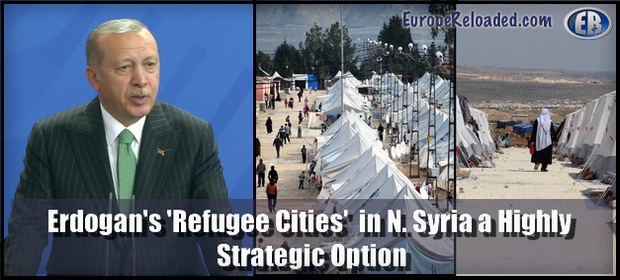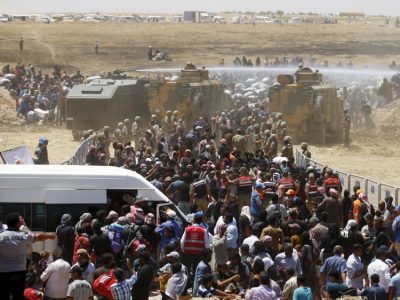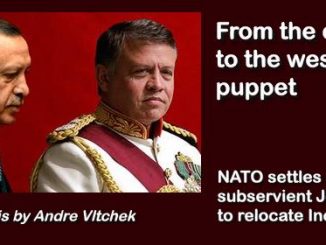
ER Editor: Recently, Turkish President Erdogan has been threatening to send large numbers of refugees housed in Turkey into the EU, most of which (3.6 million estimated) are Syrian and not Kurdish. The proposal described below, to create refugee cities (at least one) in northern Syria, would appear to be the  next step in Erodgan’s planning. This proposal was made last Monday following peace talks with Vladimir Putin and Hassan Rouhani, all three of whom are guarantors of the Astana Process concerning the future of Syria.
next step in Erodgan’s planning. This proposal was made last Monday following peace talks with Vladimir Putin and Hassan Rouhani, all three of whom are guarantors of the Astana Process concerning the future of Syria.
We also recommend this from Hurriet Daily News, Up to 3 million Syrians can be settled in safe zone: Erdoğan, detailing Erdogan’s concern over a possible 4 million people in Idlib fleeing north into Turkey as a result of continuing unrest between Assad’s forces and radical jihadist groups:
Informing that the fifth Astana Process summit that took place in Ankara has yielded important results for the stabilization of Syria, but there were still important issues that need to be sorted out, the president said.
Idlib is one of the top issues Turkish, Russian and Iranian leaders have discussed
at the summit. Idlib, a last stronghold of the moderate opposition groups and home to nearly 4 million, has been under attack by Syrian regime forces since April. The Syrian army says it fights against the radical jihadist groups there but its attacks have hit civilians as well. Around 700,000 people have already fled towards north because of the attacks.
“In the case we can’t provide calm in Idlib rapidly, we openly tell that we can’t afford [the hosting of] 4 million people living there,” Erdoğan stressed.
As Andrew Korybko analyses below, Erdogan is thinking of his territorial security, both dispensing with large numbers of Syrian refugees in Turkey while at the same time limiting the expansion of the much-hated Kurds within the northern Syrian territory. Perhaps the EU can breathe a little easier for the time being.
********
Turkey’s “Refugee City” Proposal for Syria Amounts to Demographic Engineering

Turkish President Erdogan’s recently announced proposal to build a “refugee city” in Northern Syria amounts to demographic engineering intended to stop the creation of a “Kurdish Corridor” there and also prevent the region from fully reintegrating into Damascus’ fold after the war.
Turkish President Erdogan proposed the building of a “refugee city” in Northern Syria after the latest trilateral talks with his Russian and Iranian counterparts in Ankara, declaring that
“for the refugees there (on the Syrian border), it is necessary to create a city for them to participate in agriculture. I explained to my colleagues that it is necessary to build infrastructure for them. It is necessary to prevent the formation of a terrorist corridor.”
The stated intention of his plans makes no secret of the fact that they’re supposed to thwart the creation of a “Kurdish Corridor” and therefore reinforce Turkey’s national security through the nascent “buffer zone” that it’s carving out there, which also implies that more than one “refugee city” would have to eventually be established in order to sustainably accomplish this. On the surface, this proposal is being portrayed in such a way as to maximize the support that it receives from the International Community, but it’s actually not as “purely” intended as it may seem.
Turkey’s self-interested reasons in massively returning the millions of refugees that came to its territory during the war do indeed overlap with some of the multilateral interests shared by the International Community, but the means through which they’re being pursued are a lot less noble. It’s true that the US-backed Syrian Kurds have conquered territory beyond their traditional regions in the country (where they only rarely constituted a majority in just a few local communities anyhow) and that there are credible reasons for believing that they’ve carried out ethnic cleansing against the indigenous Arab and “Turkmen” (a trendy term for simply referring to Syrian Turks) populations there, but it’s equally true that Turkey’s “refugee city” proposal also amounts to a form of demographic engineering, too, and not just in the sense of returning Northern Syria back to its pre-war status (which is practically impossible to ever do anyhow). Only a fraction of the refugees and other Syrians that came to Turkey since 2011 are from that region, so literal “outsiders” would end up being relocated there.
They, however, aren’t being considered by Turkey as such because of their nationality as Syrians and their ethnicity as either Arabs or “Turkmen”, with the unstated notion being that citizens of the same country should have the right to move anywhere within its territory that they’d like. While that approach is generally the legal standard in most states, it’s clearly being exploited in this case for self-interested demographic but also geopolitical reasons. About the first-mentioned and going beyond the obvious intent of stopping the creation of a “Kurdish Corridor”, Turkey wants to populate this sparely inhabited region with non-Kurds in order to prevent the latter from ever reviving their expansionist dreams in the future, which they’ve since “moderated” by attempting to become “more inclusive” by emphasizing their political goal of “autonomy” instead of the blatant ethnic chauvinism that used to characterize their movement. To assist with Ankara’s ambitions, it’s likely going to rely on anti-government Syrians (both Arabs and “Turkmen” alike), which conforms with its geopolitical goals.
Although no universally accepted figures have ever been released, it’s widely thought that the majority of Syrians who moved to Turkey after 2011 are opposed to their country’s democratically elected and legitimate government, and this group of people regularly claims that they don’t feel safe returning back to their homes in the now-liberated majority of the country where they used to reside because they don’t trust the authorities to guarantee their well-being and truly ensure that no legal or other consequences befall them. For the record, the Syrian government has invited them to return and even recently issued a broad amnesty, though those folks still refuse to come back for whatever their personal and/or political reasons may be. Nevertheless, Turkey also doesn’t want to continue indefinitely hosting them, especially if there’s another influx of incomers in the event that the situation deteriorates even more around Idlib, hence why it wants to relocate all of them (both the minority of those originally from the North and everyone else from elsewhere alike) to Northern Syria.
Should this plan even partially succeed, then it would create a major stumbling block to Damascus’ drive to reintegrate that part of the country into the national fold without granting it special status like its future inhabitants might demand in exchange. Furthermore, that “refugee city” (or very likely “cities”) will probably be defended by the Turkish military for at least a transitional period and then secured through pro-Turkish armed proxies, thus making it even more difficult for Damascus to reintegrate with that region and its possibly significantly sized population, without making political “concessions” such as the granting of autonomy whether for the whole region or just specific municipalities. All told, it’s understandable why Turkey is pushing for the implementation of its “refugee city” proposal because it strongly advances its strategic interests in Syria, though the most responsible members of the International Community should ask themselves if the end truly justifies the means, and if not, whether they’re even capable of modifying these plans or if they’re already a fait accompli.
************
Original article
This article was originally published on OneWorld.
Andrew Korybko is an American Moscow-based political analyst specializing in the relationship between the US strategy in Afro-Eurasia, China’s One Belt One Road global vision of New Silk Road connectivity, and Hybrid Warfare. He is a frequent contributor to Global Research.

••••
The Liberty Beacon Project is now expanding at a near exponential rate, and for this we are grateful and excited! But we must also be practical. For 7 years we have not asked for any donations, and have built this project with our own funds as we grew. We are now experiencing ever increasing growing pains due to the large number of websites and projects we represent. So we have just installed donation buttons on our websites and ask that you consider this when you visit them. Nothing is too small. We thank you for all your support and your considerations … (TLB)
••••
Comment Policy: As a privately owned web site, we reserve the right to remove comments that contain spam, advertising, vulgarity, threats of violence, racism, or personal/abusive attacks on other users. This also applies to trolling, the use of more than one alias, or just intentional mischief. Enforcement of this policy is at the discretion of this websites administrators. Repeat offenders may be blocked or permanently banned without prior warning.
••••
Disclaimer: TLB websites contain copyrighted material the use of which has not always been specifically authorized by the copyright owner. We are making such material available to our readers under the provisions of “fair use” in an effort to advance a better understanding of political, health, economic and social issues. The material on this site is distributed without profit to those who have expressed a prior interest in receiving it for research and educational purposes. If you wish to use copyrighted material for purposes other than “fair use” you must request permission from the copyright owner.
••••
Disclaimer: The information and opinions shared are for informational purposes only including, but not limited to, text, graphics, images and other material are not intended as medical advice or instruction. Nothing mentioned is intended to be a substitute for professional medical advice, diagnosis or treatment.




